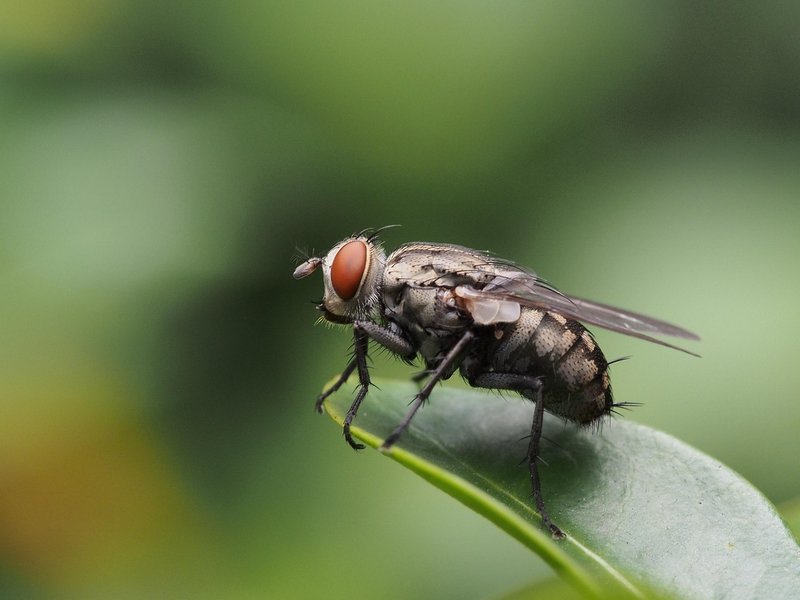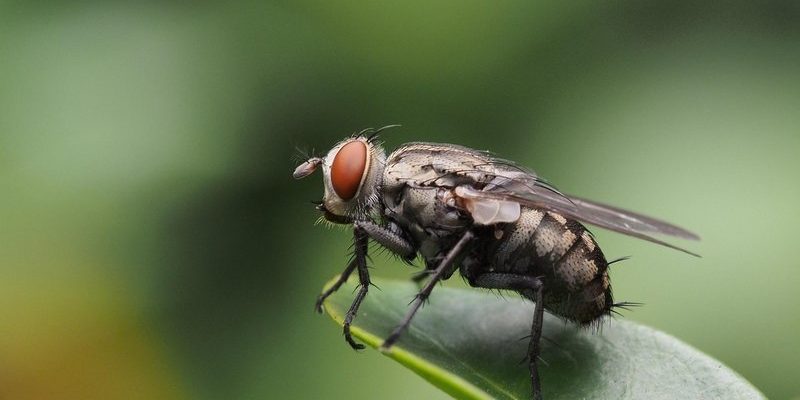
When you hear the term “Flesh Fly,” what comes to mind? If you’re feeling a bit squeamish, you’re not alone! These insects might not be on everyone’s favorite list, but they play a unique role in the ecosystem. Unlike the common house fly, flesh flies belong to the family Sarcophagidae and are often associated with carrion. But there’s more to these flies than their somewhat gruesome reputation. Let’s dive in and uncover what makes the flesh fly so intriguing.
You might think of them as the undertakers of the insect world, arriving on the scene to help break down dead animals. However, their life cycle and behaviors reveal a complex web of interactions in nature. From their distinct characteristics to their ecological roles, the flesh fly is a prime example of how even the most misunderstood creatures have important parts to play in our environment.
Physical Characteristics of Flesh Flies
The flesh fly is a striking insect, often mistaken for typical house flies but with some key differences. One of the most noticeable features is their size. On average, flesh flies measure between 8 and 14 mm in length. Their bodies are typically robust and slightly hairy, a design that aids in their lifestyle. These flies can come in various colors, but many exhibit a grayish or blackish tone, often with distinctive stripes running down their back.
Another key characteristic is their eyes. Unlike many other flies, flesh flies have large, reddish-brown compound eyes that give them excellent vision. This is crucial for spotting food sources, especially as they are attracted to the strong odors of decay. Their wings are also interesting; they have a unique pattern of dark spots and are longer than the body, providing effective mobility and agility in the air.
Life Cycle of the Flesh Fly
The life cycle of a flesh fly is fascinating and efficient. It starts with the female laying around 20 to 30 eggs on decomposing matter. This can be anything from a dead animal to rotting plant materials. These eggs hatch within just a day, revealing small, crawling larvae, often called maggots. This quick development is part of their survival strategy, allowing them to take full advantage of available food resources.
The larvae feed voraciously on the decaying flesh, growing rapidly as they digest the nutrients. After about a week, they enter the pupal stage. This is where things get a bit more interesting—unlike many other flies that encase themselves in a hard shell, flesh flies usually pupate in the soil or under debris. This protective environment helps them avoid predators and harsh weather conditions.
After a few days to weeks, depending on the temperature and conditions, adult flesh flies emerge. As adults, they live for several weeks, during which they mate and start the cycle all over again. Each stage of their life cycle is crucial, not only for their survival but also for their role in breaking down organic matter.
Habitat and Distribution
Flesh flies are found all over the world, adapting to various habitats as long as there’s a food source available. They thrive in environments rich in organic matter, such as forests, fields, and even urban areas where garbage may provide sustenance. You might spot them buzzing around picnic areas or dumpsters, seeking out smells that lead to their next meal.
While they are most active in warmer months, some species can survive in colder climates by entering a dormant state. Their adaptability means they can even make homes in places you might not expect, like abandoned buildings or under the floorboards of a house. Their ability to locate decaying matter is impressive, and they can travel quite a distance to find it.
Diet and Feeding Habits
As scavengers, flesh flies primarily feed on decomposing organic materials. They are often seen hovering around dead animals, where their larvae will thrive. Interestingly, unlike many flies that primarily feed on liquids, flesh flies can consume solid food. Their mouthparts are adapted to bite and scrape, which helps them access vital nutrients from decaying matter.
This behavior is not only beneficial to them but also serves a larger purpose. By feeding on rotting flesh, flesh flies help accelerate the decomposition process. They break down nutrients, making them available to the surrounding ecosystem. This nutrient cycling is vital for soil health, promoting the growth of plants and supporting other wildlife.
Moreover, flesh flies are important in forensic science. Their life cycle helps experts determine the time of death in criminal investigations. Understanding their feeding habits and behaviors can provide crucial information about the conditions surrounding deceased animals.
Flesh Flies and Their Role in Ecosystems
When it comes to ecosystems, flesh flies play a vital role. As decomposers, they help recycle nutrients back into the soil, which is essential for plant growth. By breaking down dead organisms, they contribute to a cleaner, healthier environment. Without them—and other decomposers—organic matter would accumulate, leading to potential issues like disease and nutrient depletion.
Flesh flies also serve as food for various predators. Birds, spiders, and other insects rely on these flies as a food source. Their presence in the food chain helps maintain the balance of various populations within ecosystems. It’s a classic case of nature’s interconnected web—each species has its part to play, no matter how small.
Additionally, the study of flesh flies contributes to our understanding of biodiversity. By observing their behaviors and interactions with other species, scientists gain insights into how ecosystems function and thrive. It reminds us that even the most overlooked creatures have stories to tell and roles to fulfill.
Table of Interesting Facts about Flesh Flies
| Common Name: | Flesh Fly |
| Family: | Sarcophagidae |
| Size: | 8-14 mm in length |
| Color: | Grayish or blackish, with stripes |
| Habitat: | Forests, fields, urban areas |
| Diet: | Decomposing organic matter |
| Life Cycle Duration: | 7 days to pupate, weeks as adults |
Common Misconceptions About Flesh Flies
With any species that has a somewhat icky reputation, misconceptions tend to pop up. Many people assume that flesh flies are synonymous with filth and disease. While they are indeed attracted to decaying matter, they do not pose a significant health risk to humans. In fact, they are often more beneficial than harmful, aiding in decay and nutrient cycling.
Another common myth is that all flies that appear similar to house flies are harmful. While some species might carry diseases or parasites, flesh flies are primarily scavengers. They mostly feed on decomposing matter, which, while not appetizing to us, is a natural and essential process in ecosystems.
Also, it’s important to note that not all flesh flies are equal. There are over 2,000 species identified around the world, each with its unique behaviors and ecological roles. Understanding this diversity is key to appreciating the complexities of these fascinating insects.
How to Control Flesh Fly Populations
If you’ve noticed an abundance of flesh flies around your home, you might be wondering how to manage their populations. The best approach is prevention—keeping your living environment clean and free of decaying organic matter is essential. Regularly dispose of trash and ensure that outdoor areas, like compost piles, are well-aerated and turned frequently.
Sealing garbage cans tightly can also prevent these flies from being attracted to your waste. If you have pets, be vigilant about cleaning up after them, as animal waste can also attract flesh flies. Keeping meat covered and promptly disposing of any animal carcasses found in or around your property can significantly reduce their presence.
In some cases, fly traps or natural repellents can help keep populations in check. Using essential oils like peppermint or eucalyptus can deter flies without harmful chemicals. However, remember that eradication isn’t always the goal. Instead, focus on maintaining a balanced environment where flesh flies can contribute positively without becoming a nuisance.
Flesh flies might not be the cuddliest of creatures, but they play a vital role in our ecosystem. From their impressive life cycles to their essential functions in decomposition, these insects embody the interconnectedness of nature. So, the next time you spot one buzzing around, remember that there’s a lot more than meets the eye. Embrace the complexities of the flesh fly and appreciate their unique contributions to our world.
FAQ
Are flesh flies harmful to humans?
Flesh flies are generally not harmful to humans. While they are attracted to decaying matter, they do not typically transmit diseases. However, like any insect, they can be a nuisance if present in large numbers, so maintaining cleanliness is key to prevention.
How can I identify a flesh fly?
Flesh flies can be identified by their robust bodies, distinctive striped pattern, and large reddish-brown eyes. They are typically gray or black, and their wings often have dark spots. If you recognize these features, you’re likely looking at a flesh fly!
What do flesh flies eat?
Flesh flies primarily feed on decomposing organic materials, including animal remains and rotting plant matter. They play a significant role in breaking down these materials, contributing to nutrient cycling in the ecosystem.
How do flesh flies reproduce?
Female flesh flies lay around 20 to 30 eggs on decaying organic matter. Once the eggs hatch, the larvae feed on the material before entering the pupal stage, eventually emerging as adults. This rapid reproduction cycle helps maintain their populations.
Where can I find flesh flies?
You can find flesh flies in various environments like forests, fields, and urban areas. They are often seen around dumpsters or anywhere there’s decaying matter. Their adaptability allows them to thrive in many habitats.
Can flesh flies be used in forensic science?
Yes, flesh flies are often studied in forensic science because their life cycle can provide crucial information about the time of death in investigations. Understanding their behaviors helps experts piece together events surrounding a death.
What is the lifespan of a flesh fly?
The lifespan of a flesh fly can vary but generally ranges from a few weeks to a month. Factors like environmental conditions can affect their lifespan, with warmer weather promoting a quicker life cycle.
How do I prevent flesh flies from entering my home?
Preventing flesh flies involves keeping your environment clean. Make sure to dispose of trash properly, seal food tightly, and clean up any organic waste outside. Regular maintenance of compost piles can also deter them.
Do flesh flies have natural predators?
Yes, flesh flies have various natural predators, including birds, spiders, and other insects. These predators help regulate the flesh fly population, maintaining a balance within the ecosystem.
Are all flesh flies the same species?
No, there are over 2,000 different species of flesh flies. Each species has unique behaviors and ecological roles, making them diverse members of the insect world.
What is the ecological importance of flesh flies?
Flesh flies play a crucial role as decomposers, breaking down organic matter and recycling nutrients back into the soil. Their activities promote soil health, support plant growth, and contribute to a balanced ecosystem.
Can flesh flies be beneficial?
Absolutely! Flesh flies aid in decomposition, which is essential for nutrient cycling. They help break down dead organic materials, making nutrients available for other organisms, thus playing a vital role in maintaining ecological balance.

